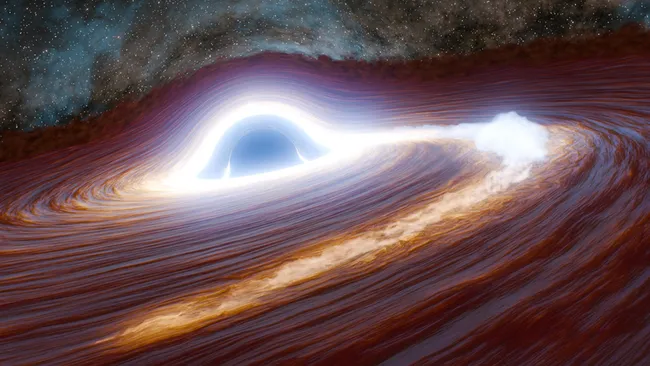Astronomers have observed the biggest black hole flare ever seen erupting around a black hole, marking the most distant detection of this phenomenon.
The Zwicky Transient Facility (ZTF) facilitated the discovery of this flare, which originated from the supermassive black hole at the center of an Active Galactic Nucleus (AGN) designated J2245+3743. The galaxy hosting this event sits 10 billion light-years from Earth. AGN are central galactic regions dominated by actively feeding, or “accreting,” supermassive black holes.
The supermassive black hole in J2245+3743 actively feeds on gas and dust whirling in its surrounding accretion disk, a flattened cloud. However, this particular flare results from a different event: an unusually massive star wandering too close to the black hole, which itself has a mass 500 million times greater than the Sun. The black hole’s immense gravitational influence is tearing the star apart, with the stellar remains fueling this cosmic titan—an occurrence scientists term a Tidal Disruption Event (TDE).
“This is unlike any AGN we’ve ever seen,” stated Matthew Graham, team leader at the California Institute of Technology (Caltech) and a ZTF scientist, in a release. “The energetics show this object is very far away and very bright.”
First spotted by the ZTF in 2018, astronomers tracked the flare as it brightened by a factor of 40 over several months. At its peak, the flare shone 30 times brighter than any previous black hole flare, emitting energy equivalent to 10 Trillion Suns. The previously most powerful TDE was nicknamed “Scary Barbie,” officially designated ZTF20abrbeie.
“If you convert our entire sun to energy, using Albert Einstein’s famous formula $E = mc^2$, that’s how much energy has been pouring out from this flare since we began observing it,” explained K. E. Saavik Ford, a team member and City University of New York (CUNY) Graduate Center researcher, in the statement.
This Biggest Black Hole Flare Ever Seen continues to fade, which signals to researchers that the black hole is still consuming the star that strayed too close. The unfortunate star is estimated to have initially possessed 30 Times the Mass of the Sun (for comparison, the star consumed during the Scary Barbie event likely held just three to 10 times the mass of the Sun). Graham colorfully described the ongoing nature of the flare in J2245+3743 as akin to “a fish only halfway down the whale’s gullet.”
The fact that gravity near supermassive black holes is so intense that time slows down near the event horizon helps the team continue its study.
“It’s a phenomenon called cosmological time dilation due to the stretching of space and time. As the light travels across expanding space to reach us, its wavelength stretches as does time itself,” Graham noted. “Seven years here is two years there. We are watching the event play back at quarter speed.” This time dilation effect demonstrates why long-term sky surveys, such as the one conducted by the ZTF, are so invaluable.
The J2245+3743 flare holds scientific interest for an additional reason. Astronomers have identified roughly 100 TDEs thus far, and most have not occurred within an AGN. This might be due to the natural activity and emissions from the accretion disk of already feeding supermassive black holes, which can effectively camouflage TDEs. Spotting TDEs around active black holes is tougher than those involving quiet, non-feeding supermassive black holes. However, the enormous size of J2245+3743 made it more conspicuous than most AGN-based TDEs.
Despite its magnitude, this black hole flare did not immediately stand out as exceptional to the team. It took until 2023, five years after its initial sighting, for data from the W. M. Keck Observatory in Hawaii to reveal the extremely energetic nature of this flare.
Initially, researchers needed to confirm that this extreme object genuinely was this bright, with energy escaping in all directions, and not merely directed straight towards Earth (a phenomenon known as beaming). The team successfully ruled out this possibility using data from NASA’s now-retired Wide-field Infrared Survey Explorer (WISE).
The team also ruled out a massive supernova explosion as the cause, thus confirming this to be the Biggest Black Hole Flare Ever Seen and indicating a TDE involving an exceptionally massive star.
“Supernovas are not bright enough to account for this. Stars this massive are rare, but we think stars within the disk of an AGN can grow larger,” Ford commented. “The matter from the disk is dumped onto stars, causing them to grow in mass.”
The discovery of this powerful flare suggests that such events may be occurring throughout the cosmos, awaiting detection. The team will continue reviewing ZTF data for similar events while also anticipating data from the upcoming Vera C. Rubin Observatory, which may uncover unusually powerful TDEs.
“We never would have found this rare event in the first place if it weren’t for ZTF,” Graham concluded. “We’ve been observing the sky with ZTF for seven years now, so when we see anything flare or change, we can see what it has done in the past and how it will evolve.”
The team’s research appeared in the journal Nature Astronomy on Tuesday (Nov. 4).

